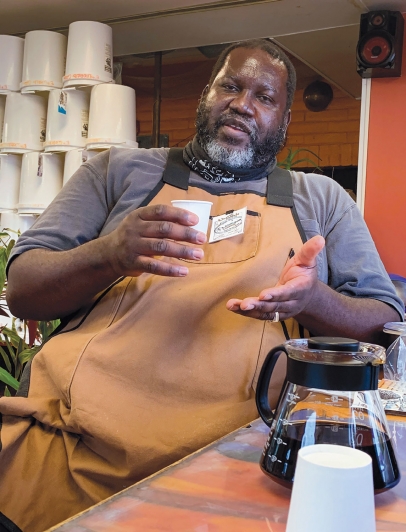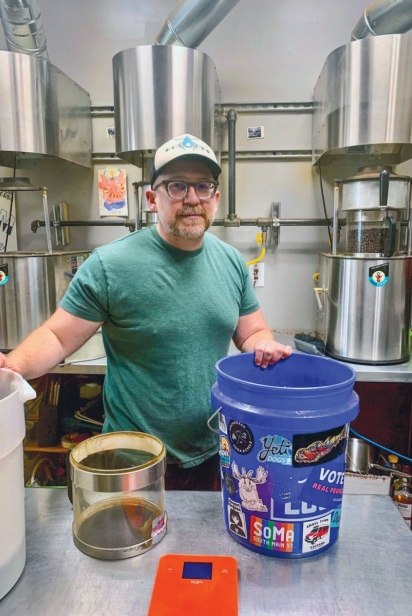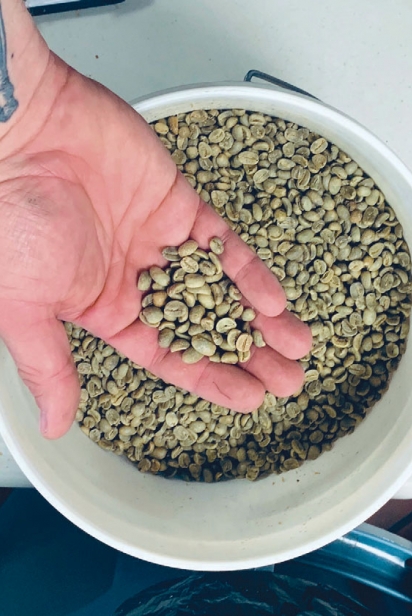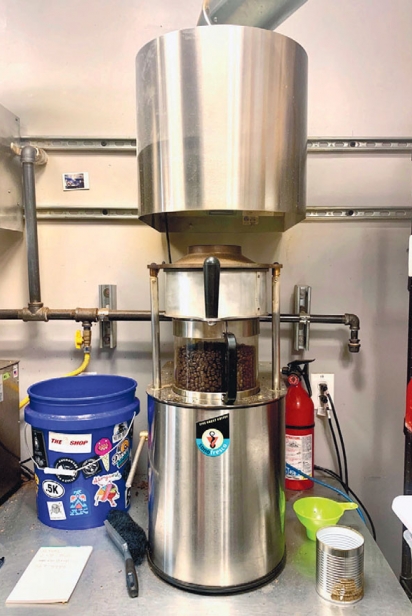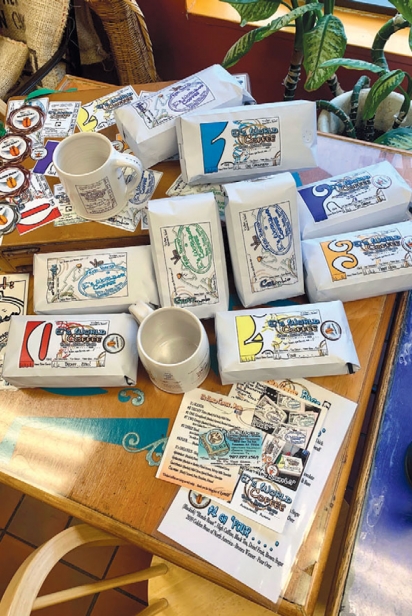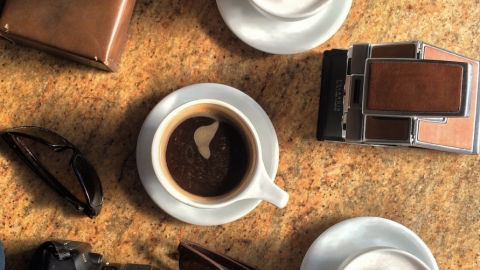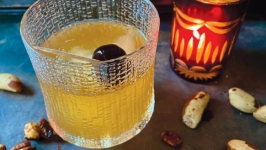Micro-Roasters Unite
If I’ve come to understand one single thing while exploring Anchorage’s micro-roast coffee scene, it’s that the individuals handcrafting small batches of the city’s newest and best coffees are some of the hardest working and most generous artisans you’ll encounter.
Many of them are still trying to adapt to, if not survive, running a small business while plumb in the throes of an upending global pandemic. When you call to talk coffee with Anchorage’s micro-roasters, you don’t reach an administrative assistant or business office, you reach (or don’t reach) the roasters directly. Several took time to meet with me while roasting or bagging coffee, or between shutting production down for the day and running to do errands. I picture A-Town Coffee’s Micheal (pronounced Michelle) Tuttle texting with one hand while operating her K-Cup machine with her other, powering up for a local school’s fundraiser.
UNCLE LEROY’S
(“YOUR NEIGHBORHOOD DIVEY COFFEE BAR”)
uncleleroyscoffee.com
Instagram: @uncleleroyscoffee
Early in my conversation with owner Austin Schwartz at Uncle Leroy’s midtown café, a young couple approaches and asks if he’ll sell them some fresh, green, unroasted beans. Schwartz politely pauses our conversation before carefully and thoroughly discussing with them what kinds of beans they needed, and what they wanted to achieve from their foray into home roasting.
Schwartz has lived in Alaska close to a decade and began roasting his own coffee in 2015, in the now famous Uncle Leroy’s bus, which soon became a fixture at Anchorage farmers markets and then in other regions of the state. That early foray into roasting was about as “small batch” as they come. “Back then we were roasting one batch at a time in a pan over the stove in the bus,” he recalls. “Each batch took about eight minutes to roast.”
Now, he and his employees roast his signature coffees using three fluid bed roasters. Unlike the Artisan brand roasters that many of his peers use, which roast up to nine pounds per roast, Schwartz’s roasters roast two pounds of coffee at a time, with a batch taking about 15—20 minutes.
“We aren’t even roasting close to capacity with our fluid beds,” he explains, sharing that he continues to see possibilities for even more creative engagement with Anchorage and its coffee culture and with fellow artisans.
Since opening the first midtown location in 2018, Uncle Leroy’s filled a niche as one of the city’s go-to coffee houses for music performances and art events so successfully that they opened a second café on the east side in February 2020—perfectly ill-timed relative to the pandemic. Uncle Leroy’s Citing cafés and urban locations influential to him before he moved in Alaska, he says he feels lucky that Leroy’s can serve the role that cafés serve more widely and intentionally in the Lower 48, and in a way that often seems otherwise scarce in Anchorage— as a venue for music or other gatherings.
Eyes scanning the tiled walls, and hands smoothing over the sleek, speakeasy, Chicago-style bar at his Midtown café, it’s little wonder the city’s indie musicians and artists would gather here, carving a space to share songs on a Sunday afternoon or First Friday. Take a good look around and see if the rustic aesthetic and beatnik vibe don’t trick you into thinking Jack Kerouac once scribbled his jazz poems here. In fact, if a rumor surfaced that a young, raspy-voiced Bob Dylan ambled through here one afternoon on his way to stardom, looking like he just stumbled out of a cotton field with Woody Guthrie, I wouldn’t be surprised.
E’S WORLD COFFEE
(“MICRO-ROASTED, MACRO-LOVED”)
esworldcoffee.com
Instagram: @esworldcoffee
“There is always something to learn about coffee,” Earnie Rawlins wisely intones, smiling, as he pauses his roasting one overcast Sunday afternoon, “and there is always too much to learn about coffee.”
Better known in the coffee community here as “E,” Rawlins exudes cheerfulness and a contagious calm that could offset the most explosive case of the caffeine jitters. For the moment, he roasts and bags his signature coffees out of Sweet Basil Café, an eatery and catering business cast among the clutter of strip malls lining Northern Lights Boulevard. Until he can move into his own warehouse, he coordinates his roasting schedule with the venue’s off-hours.
For as much as I like to think I know about coffee or have come to learn and adore about coffee culture in Alaska, I feel sheepish that I’m only now encountering Rawlins for the first time. He’s an institution in Alaska’s coffee-roasting community and has been engaged in the coffee scene here to one degree or another since the mid-1990s. In fact, as someone whose roasts over the years garnered him well-deserved praise and national recognition, roasting his “E’s World Coffees” actually marks a much-anticipated return to the city’s coffee scene.
He is also, you quickly learn, a walking encyclopedia of coffee history in Anchorage.
Born in Saint Lucia, Rawlins moved to Anchorage in 1992 on an invitation from his father, who was already living here. He became a delivery driver for Perry Merkel’s Café Del Mundo in 1994, and then moved into roasting for the company in 1996. Micro-roasting is hardly a new trend in coffee production, as E is quick to point out. Merkel, Alaska’s coffee pioneer and Café Del Mundo’s longtime owner and head roaster, started roasting coffee out of his shed in the Spenard neighborhood in 1975, well before the advent of his cafés and famous coffee blends. In addition to serving as pretty much the godfather of Alaska’s coffee culture, it seems only fair then to note that he was also Alaska’s original micro-roaster.
While Rawlins has worked or been affiliated in a variety of ways with some of Anchorage’s largest coffee producers since that time, he says he much prefers life as a self-employed micro-roaster.
“The difference between mass production and micro-roasting, for me, is I have more control of the flavors,” he explains. “You have less control of taste and quality in mass production.
“I also can afford to roast only specialty-grade, high-quality beans,” he says, “because I’m keeping my operation small and about the quality of the coffee.” For Rawlins, “quality” in terms of beans, the roasting process, and flavor proves less a cliché advertising term or a way to upsell his product and more an essential component to one’s experience of coffee.
He holds a lot of admiration and respect for his fellow micro-roasters in the community; as we talk, and sip, and sample from his blends, he offers names of fellow roasters I should meet with to discuss coffee and to better understand the growing community.
“The micro-roasting community is very supportive and friendly up here,” he says, smiling. “It’s coffee!” he announces, laughing. “There’s plenty to share! There’s plenty of love to go around! Micro-roasters, unite!”
To prove his point, he nods towards his Artisan X-e Deluxe fluid bed roaster and explains that he blew out the motor of his machine a few days earlier. Goldie’s Coffee Roasters owners, the Frederic sisters, use the same roasting machine as Rawlins and were more than happy to loan him their motor until his new one was flown in via FedEx.
Rawlins’s wife and self-described “partner in crime,” Tassita, (she goes by “Wife-E”), assists him with running the business through their website and managing their social media presence, as well as working alongside him as needed on roasting days.
It’s important to note, too, that while Rawlins possesses one of the most knowledgeable coffee minds and discriminating palates in Anchorage, he is also one of the select go-to espresso machine repairmen in Alaska. Before Perry persuaded Rawlins to begin roasting for him, Rawlins aspired to work repairing machines for companies and vendors. On his website, his contact info features two phone numbers: one is for ordering or talking the coffee production side of his business. The other is for diagnosing an espresso machine’s issue and scheduling repairs.
Editors' Note: Jonathan Bower kicks off a new occasional column examining Alaska's micro-roasting scene. Stay tuned for more.


